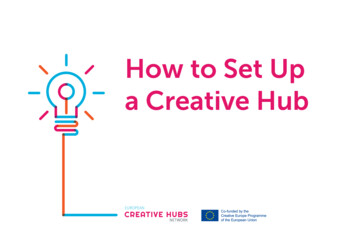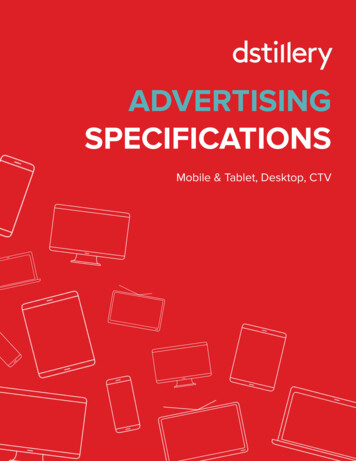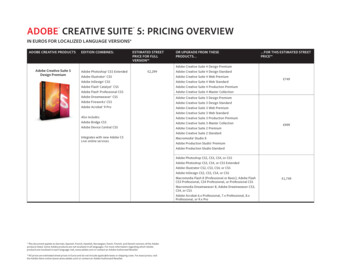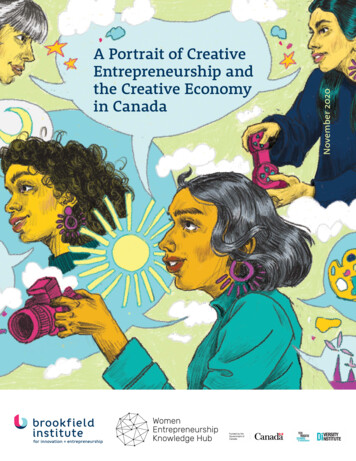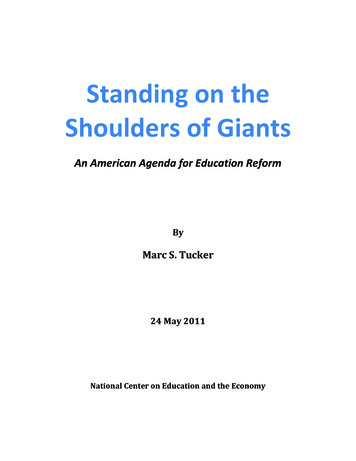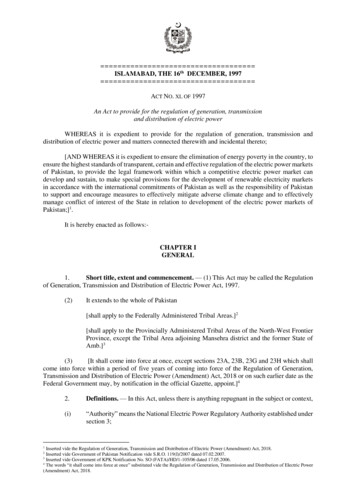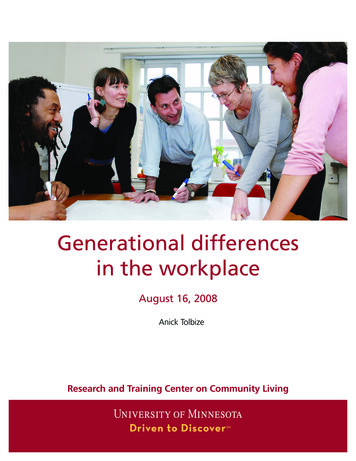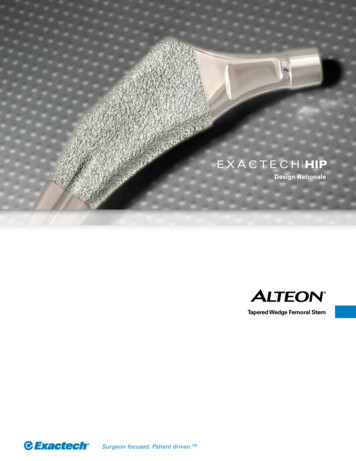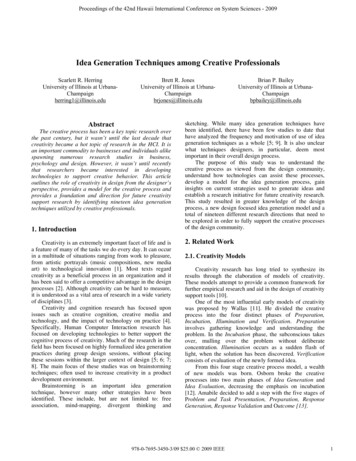
Transcription
Proceedings of the 42nd Hawaii International Conference on System Sciences - 2009Idea Generation Techniques among Creative ProfessionalsScarlett R. HerringUniversity of Illinois at UrbanaChampaignherring1@illinois.eduBrett R. JonesUniversity of Illinois at UrbanaChampaignbrjones@illinois.eduAbstractThe creative process has been a key topic research overthe past century, but it wasn’t until the last decade thatcreativity became a hot topic of research in the HCI. It isan important commodity to businesses and individuals alikespawning numerous research studies in business,psychology and design. However, it wasn’t until recentlythat researchers became interested in developingtechnologies to support creative behavior. This articleoutlines the role of creativity in design from the designer’sperspective, provides a model for the creative process andprovides a foundation and direction for future creativitysupport research by identifying nineteen idea generationtechniques utilized by creative professionals.1. IntroductionCreativity is an extremely important facet of life and isa feature of many of the tasks we do every day. It can occurin a multitude of situations ranging from work to pleasure,from artistic portrayals (music compositions, new mediaart) to technological innovation [1]. Most texts regardcreativity as a beneficial process in an organization and ithas been said to offer a competitive advantage in the designprocesses [2]. Although creativity can be hard to measure,it is understood as a vital area of research in a wide varietyof disciplines [3].Creativity and cognition research has focused uponissues such as creative cognition, creative media andtechnology, and the impact of technology on practice [4].Specifically, Human Computer Interaction research hasfocused on developing technologies to better support thecognitive process of creativity. Much of the research in thefield has been focused on highly formalized idea generationpractices during group design sessions, without placingthese sessions within the larger context of design [5; 6; 7;8]. The main focus of these studies was on brainstormingtechniques; often used to increase creativity in a productdevelopment environment.Brainstorming is an important idea generationtechnique, however many other strategies have beenidentified. These include, but are not limited to: freeassociation, mind-mapping, divergent thinking andBrian P. BaileyUniversity of Illinois at UrbanaChampaignbpbailey@illinois.edusketching. While many idea generation techniques havebeen identified, there have been few studies to date thathave analyzed the frequency and motivation of use of ideageneration techniques as a whole [5; 9]. It is also unclearwhat techniques designers, in particular, deem mostimportant in their overall design process.The purpose of this study was to understand thecreative process as viewed from the design community,understand how technologies can assist these processes,develop a model for the idea generation process, gaininsights on current strategies used to generate ideas andestablish a research initiative for future creativity research.This study resulted in greater knowledge of the designprocess, a new design focused idea generation model and atotal of nineteen different research directions that need tobe explored in order to fully support the creative processesof the design community.2. Related Work2.1. Creativity ModelsCreativity research has long tried to synthesize itsresults through the elaboration of models of creativity.These models attempt to provide a common framework forfurther empirical research and aid in the design of creativitysupport tools [10].One of the most influential early models of creativitywas proposed by Wallas [11]. He divided the creativeprocess into the four distinct phases of Preparation,Incubation, Illumination and Verification. Preparationinvolves gathering knowledge and understanding theproblem. In the Incubation phase, the subconscious takesover, mulling over the problem without deliberateconcentration. Illumination occurs as a sudden flash oflight, when the solution has been discovered. Verificationconsists of evaluation of the newly formed idea.From this four stage creative process model, a wealthof new models was born. Osborn broke the creativeprocesses into two main phases of Idea Generation andIdea Evaluation, decreasing the emphasis on incubation[12]. Amabile decided to add a step with the five stages ofProblem and Task Presentation, Preparation, ResponseGeneration, Response Validation and Outcome [13].978-0-7695-3450-3/09 25.00 2009 IEEE1
Proceedings of the 42nd Hawaii International Conference on System Sciences - 2009Shneiderman took a different approach classifying thetypes of creativity, and the creators, into the divisions ofInspirationalist, Structuralist and Situationalist [10].Arguing that creativity support tools should providesupport for the different processes resulting from differingcreative personality types. He also developed a four stagemodel of Collect, Relate, Create and Donate; placing alarge emphasis on contributing the results of a creative actto the larger community.Warr and O’Neill synthesized the main creativitymodels into a unified model of Idea Generation, ProblemPreparation and Idea Evaluation [14]. This GenericCreative Process model stressed the similarities of allprevious models and attempted to reach a uniformconsensus.complex models involving sub-processes [20; 21; 22].These models include such sub-processes as: theinvestigation of problem finding, problem formation andproblem redefinition [21; 23], sub-processes involving thedissemination or combination of information or even theprocess of generating ideas through a random process [24].Some authors have proposed models that organize the subprocesses involved. Mumford and colleagues [25] specifieda dynamic model based off of a specified set of coreprocesses (problem construction, information encoding(and retrieval), category search, specification of best fittingcategories, combination and reorganization of categoryinformation to find new solutions, idea evaluation,implementation of ideas and monitoring. The dynamicmodel allowed for cycling between different processes asdeemed necessary during the creative process.These models address the complexity involved in thecreative process. However, the complexity of these modelsmakes them difficult for wide spread use and particularlydifficult to explain to software developers. Although thesemodels provide a good theoretical background and a deeperunderstanding of the cognitive mechanisms underlyingcreativity, they do not necessarily aide in the understandingof how technologies can be developed to better support thecreative process due to their complexities.2.3 Idea generation and creativityFigure 1: Generic Creative Process ModelAdapted from Warr and O’Neill [14]While these models have been largely adopted andused in the creation of creativity support tools, there issome skepticism regarding the simplicity of currentcreativity models. Most of these models note that they arenot intended to be followed in a discrete linear fashion [14].However the representations are always portrayed in astatic, linear fashion cycling through distinct stages of thecreative process. Many authors have rejected this distinctand limited representation [15; 16; 17]; arguing thatcreativity is a “dynamic blend of processes that co-occur, ina recursive way throughout the work” [15]. These sameauthors call for a better understanding of the creativeprocess, and a better representative model. While this paperdoes not attempt the rigor of a cognitive process model, anunderstanding of existing models is useful.2.2 Cognitive Process ModelsDuring Guilford’s address to the AmericanPsychological Association in 1950 he noted the fourimportant steps of the creative process. However, he feltthe analysis was superficial from a psychological point ofview because these models did not explain the mentaloperations that occur [18]. He proposed a new program ofresearch focusing on the identification, measurement andvalidation of creativity-relevant abilities [19].From this research, many new models were developed,stepping away from the basic four process model to moreIdea generation, or the act of generating novel,applicable ideas, is the activity most frequently associatedwith creative problem solving (CPS) [26]. As the ideasgenerated in this stage are used throughout the creativeprocess, taking the idea generation phase seriously iscrucial to the success of the CPS process [27; 28; 29; 30].Research has attempted to increase the number of ideasproduced by creative professionals because a directrelationship between the number of initial ideas producedand the quality of the final idea has been established [12].Osborn stated that out of the entire CPS process,individuals are likely to experience the greatest difficultyduring idea generation [12]. This is partly due to the factthat it is difficult for individuals to suspend judgment whenformulating ideas. Individuals tend to focus more on thequality of the idea and the practicality, as opposed tofocusing on generating as many ideas as possible [13].The creative process is also inhibited by people'sinability to entertain ideas that violate previously heldassumptions, rules, and conventions [31; 32]. In otherwords, individuals must be able to break associations andpatterns of thoughts in order to create new relationshipsthat didn’t previously exist. Additionally, the ideageneration process is heavily influenced by intrinsicmotivation [13; 33]. This implies that creative professionalmust be given both the tools and the incentives to producecreative works.2
Proceedings of the 42nd Hawaii International Conference on System Sciences - 20092.4 Idea Generation TechniquesIn order to help individuals in the idea generationprocess, researchers have identified methods to stimulatecreative thought, generate more ideas, and expand on thesolution space [34; 35; 36]. These techniques categorize themethods used by creative professionals in pursuit of thecreative end product. Idea generation techniques consist ofa mixture of artificial formal techniques and classificationsof naturally occurring design practices.Smith [37] identified 172 idea generating techniquessuch as Osborn's [12] Brainstorming and SCAMPER(substitute, combine, adapt, modify, put to other use,eliminate, rearrange). Smith then distilled these techniquesinto a smaller set of active ingredients that represent thecore functionality behind each technique, similar to activeingredients in pharmaceuticals.Although many techniques have been identified, thereare a limited number of studies that have addressed thefrequency of use of idea generation techniques and theirapplicability during constrained situations, namely Lin andcolleagues [5]. Knowledge of the relative importance ofthese techniques is crucial for creativity support tooldesign, as only a few of the techniques are used frequentlyin practical design situations.2.5 Technology for idea generationThe aspiration of most creativity research is to informthe creation of tools to improve the efficiency of thecreative process and the quality of the creative results [10].A number of researchers have proposed standards andimplications for the design of creativity support tools [38].Researchers have suggested implications for the design ofcreative support systems. For example, tools have beendeveloped to aid: fine arts collaboration [39], sketching[40], creative problem solving environments [41], anddistributed scientific communities [42].Along these lines, Shneiderman built upon his threecategories of creativity by recommending ways in whichtechnology can enhance the creative process of theindividual [10]. For example, he suggested thatInspirationalists would benefit from technology thatemphasizes free association, helps the user understandprevious work and orients the user to visual techniques.Structuralists are aided by standard software packages thatallow for the organization and structuring of existing ideasand benefit from repositories of previous work.Situationalists could be aided by advanced communicationmechanisms, allowing them to share ideas and designdocuments freely.Going beyond implications for design, a number oftools have been constructed with the goal of improving thecreative process. The Electronic Paper Napkin helpsdesigners retain the ambiguity in their designs and attemptsto intelligently recognize what is being drawn [40]., SILKis an interactive idea capture tool designed to facilitaterapid prototyping. This tool aids designers in building rapidprototypes of interfaces through a unique sketchinginterface [43]. Tools such as IdeaTree and IdeaFisherprovide the user with associative linking; however a studyof these tools found them insufficient for practical use [9].While a wealth of these tools has been developed, atpresent they are not utilized within industry and the currentstudy is focused on inefficiencies in current practices indesign.3. Description of studyThe purpose of this study was not to determine whatwas unique to product design but rather to learn aboutcurrent practices in the field to guide and develop tools tobetter support those practices. We interviewed 10 designersinvolved in the product design process. Nine of thesedesigners were from three different companies and one wasa freelance designer. Seven of the interviews wereconducted in the designers’ project space, which facilitatedthe observations of artifacts and allowed us to observe theirworking environment. The other three interviews wereconducted over the phone due to geographical constraints.3.1. Who was interviewedTwo of the three companies we observed were largecorporations with internal product development groups.These two companies were situated in the service andelectronics industries. The other company we observed wasa design firm that is typically contracted by outside clientsto design end consumer products.The designers interviewed represented a range ofprofessional design experience levels (Table 1) and camefrom diverse backgrounds (Table 2). Some of the designershad professional background in many industries such asproduct design and occupational health or engineering andindustrial design. Therefore, the background of theparticipants in Table 2 do not add up to the number ofdesigners that actually participated in this study.3
Proceedings of the 42nd Hawaii International Conference on System Sciences - 2009Due to the diverse background of our participants,much of what was observed during this study is notnecessarily unique to product design but probably drawsfrom the broader traditions of design including (but notnecessarily limited to): architectural design, industrialdesign, graphic design and engineering design.3.2. What was askedAfter inquiring about the participant’s designexperience and professional background, the participantdescribed their creative process from project definition toproject completion, explaining what happened at each stageof the process. The participant was then asked to providethe interviewer with an example of a recent project.Examples of the projects discussed include next generationlawn sprayers, automobile interiors, household appliances,computer input devices and consumer packaging.The participant was then asked to describe techniquesthat were used to generate the initial design concepts forthat project, or techniques that they prefer to use in general.After the techniques had been identified, the participantwas asked about the benefits and limitations of eachtechnique. The participant was then asked to show anyrelevant examples that he or she produced during theprocess and explain its significance.4. Design cycle modelOne of the first questions participants were asked wasto describe their creative process. In reply, almost everyone of the designers described their entire productdevelopment cycle from idea creation to client presentation.In other words, the designers viewed their overall designprocess as a creative process, referencing how it isimportant to be creative throughout the entire cycle.Previous models of creativity focus mainly on the ideageneration process and do not differentiate ideas from finalproduct solutions (see the Creative Models and CognitiveProcess Model sections). Following the responses fromdesigners, the following model makes the distinctionbetween the design cycle and the idea generation process.This model aimed to merge the simplicity of the creativitymodels with the dynamic attributes of the cognitive processmodels developed by Mumford and associates [25].The design cycle consists of three phases: ideageneration, implementation and evaluation. These phasesare represented as distinct circles due to the deliberateseparation of the design cycle by time managementpractices. Under a strict deadline, designers must ensurethat they place clear boundaries between the phases in thecycle, ensuring that the product is delivered to the client onschedule. When the designer leaves the idea generationcircle he or she has an idea that she is ready to implement.Following the completion of the solution, the designerevaluates the solution and its representation. Thisevaluation leads to a new insights utilized in the nextiteration of the design cycle.Figure 2: The Design Cycle (for inset see Figure 3)34.1. IR Idea Generation ModelFocusing on the idea generation phase we discover the3IR Idea Generation Model (Figure 3). This model describesthe fluid cycle of idea generation utilized by designersduring the conceptual stage of the design cycle. Within thismodel the designer generates and refines ideas, eventuallyleaving the circle with an idea that is ready to implementand moving to the next cycle in the overarching designcycle.3Figure 3: IR Idea Generation Process ModelThe model consists of three non-distinct categories:research, represent and refine all encompassed by thecategory of inspiration. Designers search for inspirationthroughout the idea generation process in order to spark theformation of creative solutions. The process begins withresearch into the problem domain which will generate amultitude of diverging concepts. Once initial concepts areformed in the research phase they are physicallyrepresented in an externalized form. When therepresentations are solidified the designer begins to4
Proceedings of the 42nd Hawaii International Conference on System Sciences - 2009evaluate and refine the concepts eventually leading to aconvergence of concepts. The refined, validated conceptsthen guide further research and knowledge acquisitionstarting the process anew. The cycle by no means maintainsa constant speed of rotation. During the idea generationprocess a concept may be represented by a quick sketch ormay be discarded during a split second refine cycle. (Adetailed explanation of each stage occurs in theCategorization of Techniques section.)This model depicts the transference of concepts andnot ideas. This subtle distinction is emphasized to explainthe initial problem finding exploration, within which thedesigners attempt to solidify an ill-defined problem. Thus aconcept represents either a working definition of theproblem or a potential solution.5. Idea generation techniquesThe interviews were analyzed by the authors and everyreference to a distinct idea generation technique wasdocumented. This extensive list was then condensed byconglomerating similar ideas into broader categories. Forexample all references to emailing, instant messaging orasking someone a specific question were grouped into theconsultation category. These categories were carefullyrefined until agreement was met between the authors.The list of idea generation techniques was condensedin order to facilitate ease of comprehension and applicationamong creative cognition professionals. In contrast,Smith’s research [37] resulted in the identification of 172idea generation techniques. Due to the exhaustive,meticulous nature of the list it is difficult to apply duringthe development of creativity support tools.The idea generation techniques identified are brieflyintroduced as follows:1. Role Playing: Role playing involves designers actingout scenarios. These scenarios are often ones that thedesigners observed during the research phase of thedesign process when they participated in user research.This technique is a tool for both team-based ideationand communication to users and/or clients [44; 45].2. Active Search: Active search refers to designershunting for a particular solution. This hunt could rangefrom a web search for images of current vacuumcleaners to searching through books, magazines,newspapers, etc. to find the demographics of aparticular population [46].3. Attribute List: Attribute listing refers to taking anexisting product or system, breaking it into parts andthen recombining these to identify new forms of theproduct or system [47; 48].4. Brainstorm: Brainstorming involves generating a largenumber of solutions to a problem (idea) with a focuson the quantity of ideas. During this process, no ideasare evaluated; in fact unusual ideas are welcomed.Ideas are often combined to form a single good idea assuggested by the slogan “1 1 3” [12]. Brainstormingcan be used by groups as well as individuals [49].Since brainstorming was the first idea generationtechnique created it is often referred to as, “the motherof all idea generation techniques” [50].5. Collaborate: Collaboration refers to two or morepeople working together towards a common goal [51].Designers often work in groups and co-create duringthe entire creative process.6. Concrete Stimuli: Concrete stimuli are used whendesigners want to gain new perspectives on a problemby manipulating physical materials. This could belooking at paint chips, feeling different materialtextures or physically maneuvering objects.7. Critique: Critique refers to receiving input on currentdesign ideas. This could be collaborative such asreceiving a design critique from a colleague orindividuals critiquing their own ideas (eithersystematically or intrinsically). This technique oftenspurs new thought by finding solutions to design flawswithin current concepts.8. Documenting: Documenting refers to designers writingdown ideas (physically or electronically). This includesjournaling, writing stories, and taking notes.9. Expert Opinion: Designers often elicit opinions fromexperts to identify potential problems with products orservices before more comprehensive evaluations. Thisoccurs when they are looking for an answer to aproblem that is outside their domain knowledge orwhen they want to test a new idea [52; 53].10. Empathy/User Research: User research requires thedesigner to observe people in everyday situations inorder to develop empathy for them. The methods usedto conduct this type of research is founded inethnographic research methods such as observations,field studies and rapid ethnography [44; 54].11. Encompass: Encompassing is an inspirational techniquewhich involves designers immersing themselves ininformation relevant to the current project.12. Forced Analogy: Forced analogy involves comparingthe current problem with something else that has little ornothing in common in order to gain new insights andresults. This technique often generates ideas for newareas of research. [55; 56]13. Incubate: Incubation refers to stepping back from theproblem to let the subconscious mind work [11].14. Passive Searching: Passive searching refers to designerslooking through material (web, magazines, books) forinspiration without searching for a particular solution toa problem. They are simply looking for inspiration.15. Prototyping: Prototyping, in this study, refers to a lowfidelity model of an idea. These models can be createdwith any type of material (paper, clay, etc.) as they areonly used to conceptualize a thought.16. Reflect: Reflection occurs when designers review theirprevious work (sketches, documents, prototypes, etc.)17. Sketching: Sketching refers to a rough drawing of anidea.18. Socializing: Socializing refers to talking with othersabout topics unrelated to the current project.5
Proceedings of the 42nd Hawaii International Conference on System Sciences - 200919. Storyboards: Storyboards are a way for designers torepresent information gained in the research phase ofthe design process. Quotes from the user, pictures, andother relative information are placed on cork board, or asimilar surface, to represent a scenario and to helpunderstand the relationships between design ideas.Designers often post information about users using aslittle detail as possible to allow for interpretation ofinformation [57; 58].Technique(% Referenced)Active Search (100)ResearchxAttribute List (40)Brainstorm (80)RepresentRefineInspireXxxxxxXxCollaborate (60)xxXxConcrete Stimuli (2)xxCritique (90)Documenting (60)Expert Opinion(90)Empathy/ UserResearch (80)XxxxXxxxxxPrototyping (70)xxRole Playing (10)Sketching (100)xxXxxxxxxxSocialize (30)Storyboarding (40)5.3. ResearchxIncubate (30)Passive Searching(60)Reflect (60)xxEncompass (50)Forced Analogy (5)xxbooks. Designers reported checking web blogs on a dailybasis. Many designers also said they frequently search onthe internet, “The internet is obviously a god-send. Thereare a few good websites that people frequent around here.(We) Spend time just looking through ideas.”Designers also reported immersing themselves ininformation relevant to the current project, “It helps me tobe really physical. You took photos, you took video. Maybeyou built some prototypes. But you try to get it up in yourspace and spread it all out.” Designers reported going intotheir project space and reflecting, looking at all of theinformation and “finding out what is really important”.Another method designer’s use is to socialize.Socializing refers to talking to someone about anythingunrelated to the project at hand such as the weather, sportsor politics. This allows them to clear their mind for newideas to immerge.Finally, designers incubate to find inspiration or letinformation ‘sink in; Some incubation methods mentionedby designers were taking showers and going on walks.xTable 3: Categorization of idea generation techniques5.1. Categorization of techniquesAfter the 19 idea generation techniques were3identified, they were categorized and placed into the IRmodel according to what the technique was used for(inspiration, research, representation or refinement). Thetechniques were placed into the boundary areas of themodel if the technique served many purposes. Thereforesome techniques are placed on the boundaries between twocategories or in the middle of the model if they encompassall aspects of the ideation process, see Table 3. A detaileddescription of the categories and the explanations oftechnique placement are described below.5.2. InspirationAs previously mentioned, inspiration can occur at anystage within the idea generation process. Many designersmentioned solely inspirational idea generation techniquessuch as: passive searching, encompassing themselves in thematerial, socializing, and incubating. Passive searchingrefers to searching without a particular concept in mind. Inparticular they search to, “Get inspiration, (when you) don'teven know what you are looking for”. Many designersreported searching through magazines, web sites, andDuring the research phase of the idea generationprocess, designers try to gain additional knowledge to helpthem identify potential solutions. This acquisition ofknowledge could include anything from user research, toactive web searches, to reflecting on previous work.In this investigation, designers reported the necessityto have upfront empathy with the users. In order fordesigners to achieve empathy with their users, they mustconduct user research. Although designers might have aclear audience in mind, they often use forced analogies todevelop a larger research area. For example, one designerwas developing a new interior cab design for a commercialtruck. In order to develop empathy for the user, thedesigner interviewed people who lived in small spaces suchas small houses and semi sleepers. This forced analogyallows designers to research a broader area and gainadditional knowledge.In addition to the upfront user research, designers oftenreflect on their previous work. This work often comes inthe form of pictures, physical prototypes, reports, sketches,etc. Designers can also perform an active search wherethey search for particular information. For example, if adesigner is designing a new water bottle they could performa web search for relevant pictures of water bottles or namesof manufacturing companies. Although this type of searchcould take place in the web, it could also be performed bylooking through books, magazines, newspapers, etc.Sketches or documentation (physical or electronic) isalso utilized during the research phase. The designersketches possible solutions as well as documents his or herjourney by journaling (writing stories/ notes), “Sometimesthe best way for me to think is to sketch to sketch and towrite . 90% of my notebooks is stuff I’m thinking (ithelps me) organize my thoughts.” Designers often use thesesketches and document to generate ideas in the next phase6
Proceedings of the 42nd Hawaii International Conference on System Sciences - 2009(represent), “Sometimes I get to the best sketch by writing,sometimes I get to the best story by sketching”.5.4. RepresentDuring this represent phase of the idea generationprocess, designers use physical objects to represent theirdesign ideas. As previously stated, sketching anddocumenting are both used during the representation phaseof the idea generation process. However, in this phase thedesigners use sketching and documenting as a way toconceptualize their idea,
University of Illinois at Urbana-Champaign herring1@illinois.edu Brett R. Jones University of Illinois at Urbana-Champaign brjones@illinois.edu Brian P. Bailey University of Illinois at Urbana-Champaign bpbailey@illinois.edu Abstract The creative process has been a key topic research over the past century, but it wasn't until the last decade that
